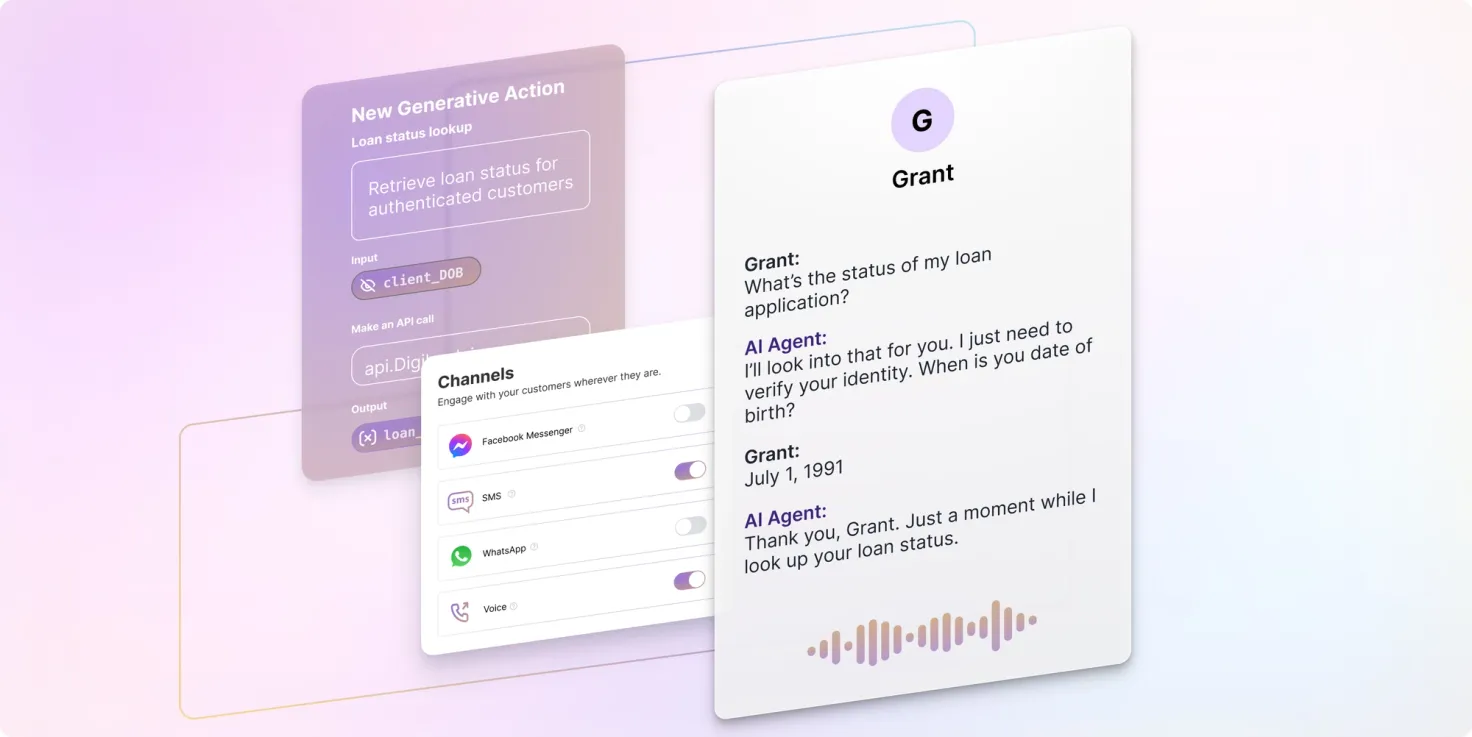
how to prioritize tech stack investments for AI customer service
Learn how to invest in systems that boost AI performance, CSAT, and ROI, without bloating your customer service tech stack.
Learn More

AI isn’t just changing banking—it’s rewriting the rulebook.
From Capital One leveraging advanced cloud services to accelerate AI adoption to JP Morgan equipping 140,000 employees with generative AI tools, the financial industry is pulling out all the stops to stay ahead streamlining workflows across its global operations. Bank of America alone poured $3.8 billion into cutting edge AI last year, and it’s not slowing down.
Why the rush? Because A has the power to transform the industry and unlock up to $1 trillion in value—equivalent to 15.4% of the sector’s total revenue.
But here’s the kicker: It’s no longer just about growth. It’s about survival. Banks that lag behind risk being outpaced by faster, leaner, more innovative competitors.
As PwC aptly put it:
“If your business is operating in one of the sectors or economies that is gearing up for fast adoption of AI, you’ll have to move quickly if you want to capitalize on the openings, and ensure your business doesn’t lose out to faster-moving and more cost-efficient competitors.”
This guide dives deep into conversational AI , the game-changing technology reshaping customer experiences in banking. Ready to see how it can redefine your strategy? Let’s get started.
In today’s banking landscape, customers demand quick, accurate, and human-like support—available 24/7. That’s where conversational AI steps in. Unlike traditional chatbots that rely on predefined scripts, conversational AI leverages advanced technologies to understand context, intent, and even nuance. This means it can handle complex customer queries with ease.
If you’ve used a basic chatbot before, you know how frustrating it can be. Traditional chatbots rely on rigid, keyword-driven scripts. Ask something outside their programmed knowledge, and they hit a dead end.
Conversational AI is a game-changer. It uses Natural Language Processing (NLP) to grasp customer intent, making interactions smoother and more intuitive. While basic AI chatbots can manage simple troubleshooting, they have clear limitations. Conversational AI, however, goes beyond, learning from every interaction and continually improving its ability to deliver personalized, meaningful support.
Banks adopting conversational AI are essentially hiring digital bankers—AI agents that can:
By retaining context and continuously learning, conversational AI offers the sophisticated, omnichannel support modern customers expect.
To deliver exceptional service, conversational AI agents in banking must excel in these areas:
Imagine a world where your bank anticipates your needs before you even voice them—offering real-time fraud alerts, personalized budgeting insights, and instant resolutions across your favorite channels. That’s the promise of conversational AI in banking.
By seamlessly blending human-like interactions with advanced automation, conversational AI is setting a new gold standard for customer service in the financial industry. From faster responses to reduced costs and increased revenue, here’s how conversational AI is reshaping the banking experience:
Today’s customers expect support on their terms—instant, accurate, and available 24/7. Conversational AI delivers on this promise by responding to inquiries across chat, email, and voice channels in seconds.
This speed directly impacts a critical metric: Automated Resolution Rate (ARR). ARR measures the percentage of customer inquiries resolved without human intervention. Higher ARR doesn’t just enhance efficiency—it transforms your support department from a cost center to a strategic advantage.
With conversational AI integrated into your banking systems, tasks like fetching account balances, transaction histories, and payment statuses become near-instantaneous. Customers get what they need, when they need it, with zero wait times.

Personalization isn’t just a nice-to-have anymore; it’s a must. In fact, 81% of banking customers attempt self-service before turning to a human agent. Conversational AI empowers this shift by delivering tailored support that feels anything but generic.
Picture this: You’re setting up a new app to manage your finances, but linking your bank account feels daunting. Instead of struggling through endless steps, you ask the AI agent for help. Instantly, it provides clear, step-by-step instructions tailored to your needs. From verifying your identity to completing the connection, the process is seamless—no confusion, no frustration.
By leveraging customer data, conversational AI creates meaningful interactions that build loyalty and trust, one conversation at a time.

The numbers don’t lie: generative AI can cut customer service costs by 20 to 30% . Conversational AI achieves this by scaling effortlessly, improving operational efficiency, and eliminating costly human errors.
Consider this: Your support agents are inundated with repetitive queries like overdraft fee complaints. Not only does this drain morale, but it also increases response times. Conversational AI thrives on handling these routine inquiries, freeing up your human agents to focus on strategic, high-value tasks like customer engagement and experience design.
Even during peak periods—think tax season or year-end—AI agents maintain the same high level of performance without requiring overtime pay or temporary hires. Plus, they’re immune to the mistakes that come with fatigue, ensuring consistent and error-free service.
Boosting revenue isn’t just about acquiring new customers—it’s about maximizing the value of your existing ones. Conversational AI excels at recognizing opportunities for upselling and cross-selling during natural conversations.
For example, if a customer inquires about upgrading to a premium savings account, the AI agent might also suggest a credit card with exclusive benefits for that tier. Similarly, someone exploring deposit options could receive tailored insights about mutual funds or other investment opportunities.
These smart recommendations don’t just increase your topline; they enhance the customer experience by delivering value at every step.
By now, you’ve likely seen how conversational AI can automate repetitive tasks and field complex support queries. But the real magic lies in its measurable impact on your bank’s bottom line.
Let’s dive into how conversational AI agents deliver value that’s not just theoretical—it’s tangible and transformative.
Personalization is no longer just a buzzword—it’s a proven driver of business outcomes for banks. Yet, most institutions struggle to deliver truly tailored experiences, often relying on manual processes or siloed data. In fact, only 28% of banks can rapidly integrate internal customer data to fuel their AI initiatives.
That’s where conversational AI changes the game. These AI agents don’t just engage customers; they analyze interaction data to uncover financial insights that drive smarter decisions—for both your bank and your customers.
Imagine this: A customer logs into your banking app and asks, “How can I save more this month?” Instead of offering generic advice like “cut down on coffee,” your AI agent uses historical transaction data to craft personalized savings tips based on spending patterns.
This approach benefits everyone. Customers receive tailored guidance that feels truly helpful, while your bank gains valuable data to refine product strategies and address common pain points.

Boosting revenue isn’t just about acquiring new customers—it’s about unlocking opportunities within your existing base. Conversational AI excels at this, identifying upsell and cross-sell moments during live interactions, 24/7.
For example, let’s say you’ve launched a new credit card and experience a 3x spike in inquiries. Traditionally, this would require hiring temps—a costly and time-consuming solution. With conversational AI, your AI agent seamlessly fields thousands of concurrent queries, recommending the card’s benefits while helping customers compare options.
Even better, these interactions happen at the speed of automation. Speed and responsiveness are critical; 64% of customers prioritize them when deciding where to bank. With conversational AI for banking, you’re not just keeping up—you’re staying ahead.

First impressions matter, especially when people’s hard-earned money’s involved. Conversational AI transforms onboarding into a guided, intuitive experience that feels effortless.
Picture this: A new customer wants to open an account. Your AI agent walks them through the entire process—uploading documents, setting up a PIN, and even explaining key features along the way. Over time, the AI learns from user behavior, fine-tuning the onboarding flow to suit different customer types.
Retail customers? They get a quick and simple experience. High-net-worth individuals? The process adjusts to gather detailed insights, ensuring every interaction is tailored to the customer’s needs.
In today’s global economy, banks serve customers across languages, cultures, and channels. Meeting these diverse needs can stretch even the largest support teams. Conversational AI offers a smarter solution.
Think of it as your multilingual, omnipresent support agent. Need to assist a customer in German? The AI responds fluently. Have a query on social messaging at 3 a.m.? It’s handled instantly. And with its ability to adapt to cultural nuances, your AI agent ensures every interaction feels personal and respectful.
71% of customers believe it’s extremely important that a brand promotes and supports its products and services in their native language.
- Unbabel
What’s more, conversational AI supports your customers seamlessly across platforms—chat, email, SMS, phone, and social media—without duplicate effort. With Ada’s AI Agent, you can deliver consistent, high-quality experiences no matter where your customers connect with you.
Not all customers are created equal, and conversational AI can adapt interactions to suit specific customer segments, such as VIP clients versus Basic Tier users.
Consider this: A VIP customer needs investment advice and expects a high-touch experience. The AI agent can prioritize these customers, offering exclusive insights, proactive alerts, and direct access to human advisors when needed. Meanwhile, a Basic Tier customer looking to open a savings account is guided through a streamlined, self-service flow that minimizes friction.
This level of segmentation allows your bank to meet diverse customer expectations without overburdening your team. By tailoring interactions based on customer profiles, conversational AI ensures every customer feels valued, while your bank maximizes efficiency and satisfaction.
Decided to bring an AI agent onboard? Great move. Now comes the crucial part: implementation. To ensure a smooth transition and maximize ROI, follow these steps to lay the groundwork, train your AI, and deploy it effectively.
Before diving in, start by defining your key challenges. Is your goal to handle customer support overload? Or are you aiming to deliver personalized service at scale? Having clear objectives will shape your approach and set you up for success.
Next, evaluate your tech stack. Does your CRM, core banking system, or payment gateway support seamless integration? Your AI agent is only as effective as the data it can access, so integration readiness is critical.
Pro tip: Book a demo before committing to an AI solution. Ask specific questions about how the platform will address your bank’s unique needs, and ensure it aligns with your current infrastructure.
A well-trained AI agent is like a skilled team member—it needs the right knowledge to perform effectively. Start by familiarizing your AI with banking terminology. Teach it terms like APR, escrow, and ACH, and tailor its understanding to your institution’s operations.
If you have a knowledge base, use it to train the AI agent, along with past customer interactions. This boosts contextual accuracy and prepares it to handle real-world scenarios.
Before full deployment, test its performance with real-life scenarios. For example:
Run a beta launch with employees or a small customer segment to identify glitches and fine-tune the system. This iterative approach ensures your AI agent is polished and ready to deliver value from day one.
Pro tip: Prioritize training the AI agent on your highest-volume queries first. These are often repetitive and straightforward, making them ideal for automation and offering quick wins for your team.
Start small. Choose a single channel—like your website—for initial deployment. Once the AI agent demonstrates success, expand to other channels, such as social media, chat apps, or email.
Even with advanced AI agents like Ada’s, some customers may prefer speaking to a human. That’s where seamless escalation shines. The right AI agent ensures that human agents receive full context and account details, so customers never have to repeat themselves—a small touch that goes a long way in building trust.
As your AI agent interacts with customers, it will continuously collect valuable data. Use predictive analytics to turn this data into actionable insights. For instance:
Pro Tip: Regularly review the AI agent’s performance data to uncover opportunities for expansion or refinement. For example, identify where automation could save time or add value, then prioritize those areas for optimization.
Ada has now become an extension of Wave’s CX operations, acting as an interaction layer between the brand and its customers.
See case study
Generative AI has already begun transforming the way banks serve their customers. Moving beyond pre-programmed scripts, these advanced systems craft real-time, contextual, and highly personalized conversations that mimic human interactions.
Looking ahead, generative AI is set to rewrite the rules of banking customer service. Here’s what the future holds:
While these capabilities are on the horizon, many are already taking shape today. As banks refine AI’s reliability, they can confidently incorporate it into high-stakes scenarios like financial planning or credit scoring.
As service-driven businesses, banks face immense pressure to handle a tidal wave of support requests while maintaining quality and efficiency. Traditional scaling—adding more staff, equipment, or space—is costly and unsustainable. Conversational AI solves these challenges by scaling dynamically with demand.
But this technology is about more than just efficiency. By delivering instant, personalized responses at scale, conversational AI elevates the customer experience, boosting retention and revenue. The proof is in the results: satisfied customers, streamlined operations, and a significant competitive advantage.
In today’s landscape, conversational AI has moved past its experimental phase. It’s a proven tool, yet one that can still give digital banking an edge—provided you choose the right solution .
Are you ready to lead the way?
The key to thriving in this AI era is understanding where your current customer service operation stands and knowing exactly what’s needed to launch and grow a successful AI Customer Experience (ACX) program.
Get the guide